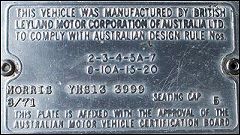|
Jan 69
|
ADR 4 - Seat Belts.
Requirements for seatbelts for
all adult seating positions to restrain vehicle occupants
under impact conditions. Specifies the type of belt, material
properties and buckle design features. Compliance with
Australian Standards is necessary but not sufficient proof of
compliance with this design rule.
|
|
ADR
5A - Seat Belt Anchorages.
Requirements for seat belt
anchorage points to ensure that seat belt assemblies are
securely fixed to the vehicle structure in specified areas
and provide a safe and comfortable restraint system.
|
|
Jan 70
|
ADR
7 - Hydraulic Brake Hoses.
Specifies minimum standards of
performance and durability for flexible hoses and end
fittings in hydraulic brake systems to reduce risk of
failure. Hose assemblies marked 'SAE J 1401' are
acceptable.
|
|
July 70
|
ADR 20 - Safety Rims.
Specifies that wheel rims on
passenger cars will retain a deflated tyre in the event of
sudden loss of pressure as in a blow-out.
|
|
Jan 71
|
ADR 2 - Door Latches and Hinges.
Side door latch and striker
assemblies and hinges that are able to resist accidental
opening through crash impact or distortion. When locked by
controls inside the vehicle, outside door handles must be
inoperative. When locked, regardless of operation of other
child-proof locking systems, if fitted, the rear doors must
not open by movement of the inner door handle. There must
also be a fully latched and a secondary latched
position.
|
|
ADR 3 - Seat Anchorages.
Requirements for seats, their
attachment assemblies and installation to reduce failure in
crashes. Hinged or folding seats must be self-locking with
the lock release within reach of the seat occupant or any
other person seated immediately behind the seat. ADR 3A
specifies additional requirements for seats intended to be
fitted with child restraints.
|
|
ADR 10A - Steering Columns.
Requires that steering wheel and
column assemblies must collapse under specified forces to
reduce injuries to drivers on impact and limits the
horizontal intrusion of the steering column into the
cabin.
|
|
ADR 15 - Demisting of Windscreens.
Specifies requirements for
demisting equipment to maintain the driver's forward vision
clear of mist.
|
|
July 71
|
ADR 8 - Safety Glass.
Requires glass in motor vehicle
windscreens, windows and interior partitions to be of an
automotive safety type such as toughened or laminated (and be
so marked). Windscreens must be clear glass and transmit at
least 75% of visible light in the primary vision area. Tinted
bands are permissible outside this area.
|
|
Jan 72
|
ADR 1 - Reversing Signal Lamps.
Lamps that are switched on
automatically whenever reverse gear is selected and the
ignition is on to signal the driver's intention to reverse
and to aid the driver in reversing manoeuvres at night. These
lamps must only operate when the vehicle is in reverse gear
and must be amber or white.
|
|
ADR 14 - Rear Vision Mirrors.
Defines requirements for the
type, location, field of view, reflecting capabilities and
mounting details of rear vision mirrors. The internal and
right-hand side external mirrors required under this ADR must
be flat.
|
|
ADR 9 - Automatic Transmission Controls.
Repealed. However, the
requirements for automatic transmission controls are now in
ADR 42 which includes the requirement that the engine of a
vehicle fitted with an automatic transmission must not be
capable of being started in any forward or reverse
gear.
|
|
ADR 11 - Internal Sun Visors.
If fitted, sun visors must be
suitably padded and without dangerous projections or
noticeable internal frames in order to reduce head injury on
impact with the visor or panel work or windscreen glass
behind it.
|
|
ADR 21 - Instrument Panels.
Provides for instrument panels to
be suitably padded and free of any sharp projections and
edges to reduce head injury on impact.
|
|
Jan 73
|
ADR 6 - Direction Turn Signal Lamps.
Specifies flashing amber lamps at
front and rear with specified levels of brightness and fields
of view and readily distinguishable to warn other road users
of the driver's intention to turn to the right or
left.
|
|
ADR 12 - Glare Reduction in Field of View.
Requires a low reflective finish
on windscreen wiper arms and blades, interior windscreen
mouldings, horn rings and steering wheel components. interior
rear vision mirror frames and mountings, steering column
mounted control lever and gear selection quadrants to
minimise glare from these features in the driver's field of
view.
|
|
ADR 16 - Windscreen Wipers and Washers.
Wipers to have two operating
speeds and be capable of wiping defined areas of the
windscreen, with washers able to supply sufficient fluid to
the wipers over ten wiping cycles.
|


